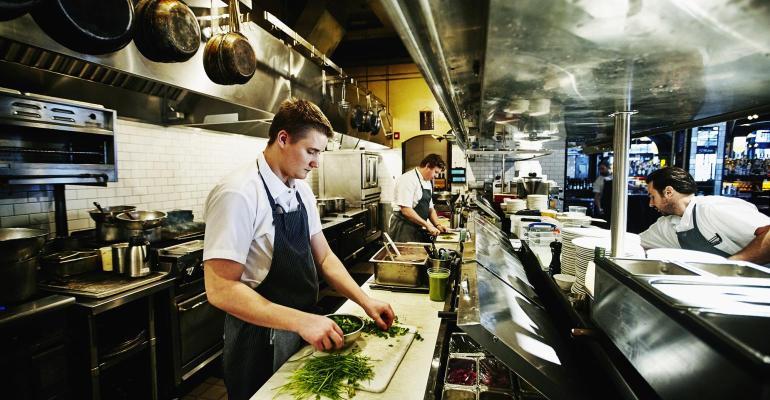How important do you feel your employees are to your restaurant success (or failure)?
Let’s face it, human nature combined with ego makes us quick to jump to blaming others when we don’t hit our numbers, when bad reviews come in, when things go awry. But true leaders take responsibility for both the victories and defeats. So I’m thrilled to acknowledge Christy Perault for writing to me after reading last month’s article, “Managing vs. Leading,” to ask how to engage the new generations, get more information on the E3 + 1 Recipe to build culture, and recognize your employees as your biggest asset.
Christy is the general manager at Cherokee Grill Steakhouse in Gatlinburg, Tenn., and is a wonderful example of the type of leader a restaurant would want at the helm. She clearly cares and appreciates her people. She credits them, in fact, for being their biggest asset.
Christy writes: “I’m very interested in more info on E3 plus 1 Recipe to help build culture in my restaurant. I find it’s harder than ever to engage with new generations and am looking for any help I can find. Being in a busy tourist town proves more than ever our employees are our biggest asset.”
Mastering the art of engaging newer generations is the key to fostering a culture of collaboration and achievement. Although there's no one-size-fits-all solution, consider these three powerful suggestions:
How To Engage New, Younger Generations:
- Embrace technology and digital platforms: Younger generations are digital natives who are therefore comfortable with technology. To help engage them and capture their attention, you need to “speak their language”, how they like to engage, and where they communicate by utilizing social media, mobile apps, and online platforms for communication, collaboration, and learning. Besides making information easily accessible through digital channels, create interactive and visually appealing content. The newer generations are much more visual learners as a whole due to growing up with technology and social media.
- Provide opportunities for skill development and growth: Younger generations value continuous learning and personal growth. They are definitely the “WIIFM” generations (“What’s In It For Me”), but while also wanting to know their work is meaningful and impacting others. Offer mentorship programs, workshops, and training opportunities that focus on both professional and personal development. They want to not only learn skills, but also grow as a whole person. Create clear pathways for advancement within the organization and make sure they are aware of them so they can see themselves in your organization for the long term, not just a one-off “j-o-b” resulting in costly high turnover. Highlight the skills they can acquire to succeed internally, and in life once they go on to what’s next in their life. This shows you are investing in them as a person, not just a task-driven employee, so they will invest their time, dedication, and loyalty in your business.
- Foster meaningful and inclusive environments: Younger generations seek purpose and a sense of belonging in their work. Showcase your company's values, social responsibility initiatives, involvement in your local communities, and your commitment to diversity and inclusion. People want to see themselves represented whether it's with leadership, fellow employees, or customers seeing others like themselves serving them, or dining with them.
Open communication is huge, so be sure to encourage it and provide multiple safe avenues for your team members to express themselves. Don’t just hear what they’re saying, but really listen to their ideas; try them out involving them. When they are involved in the decision-making processes, where possible, they will feel valued and connected.
Additionally, Christy asked to learn more about the E3 + 1 Recipe for attraction and retention to create a positive company culture. I’m happy to speak with you directly about why it’s a no-fail strategy, but for the purpose of this month’s response to the question, I will summarize the proprietary process, which addresses the challenge of connecting with today's youth and reflects the growing importance of employees in the restaurant industry, to boost your restaurant’s productivity and profitability.
E3+1 = Education. Engage. Entrust. + Empathy.
Education. Do not (just) train your people! As contrarian as it may sound, this is a pivotal piece that differentiates the Jill Raff Group approach from others. “Training” is task-oriented and temporary, as all things change as technology does at whiplash speed. We must be agile and adaptable to shift with those changes. These functional skills are also crucial, of course, to deliver an outstanding customer experience, but an education lasts a lifetime. From the first interaction, whether it’s a phone call (through how you speak, word choices, etc.), a conversation with a recruiter, a direct interview, or on the job, the company must educate on their company’s core values, expectations (in both directions — what an employee can expect from the company and what the company expects from their employees), brand promise, etc.
I was fortunate to learn this at an early age and throughout my life from my parents as mentors and role-models, being early owner/operators of McDonald's. Opened in 1959, McDonald's store #150 was their first in Ocala, Fla. When recently interviewing past employees who started working at their stores when they were just teenagers (decades ago), I learned so much that seemed matter of fact for me. I realize now I was blessed to learn from the best source directly and worked in the business for decades. It’s in my DNA. One crew member turned supervisor was Mr. John Mimbs, who started at 17. He told me, “I learned my values from your dad and working at McDonald's. He told me, ‘John, I’m going to teach you everything I know so you can succeed.’”
Show your people you care. Create those relationships as you educate and invest in knowing them and teaching them! John also told me, “Your dad was different. He cared. He really, really cared. I felt as close to him as I did my own dad. I could talk to him about everything. I knew he had my back.” He went on to say, “We all stayed with him. I've never seen that commitment elsewhere.” There’s that retention every restaurant seeks so desperately! Education is the most important foundational step.
Engage. To engage effectively, the first step of educating your employees must have been done thoroughly and must continue on a daily basis. Now it's time for action. If you expect your employees to engage with one another as a collective and supportive team, to then be able to engage in a warm professional way with your customers, you must model that behavior as leaders, and engage with them. This doesn't mean telling them what to do, it means rolling up your sleeves and being there on the floor working with them shoulder-to-shoulder. This is the work ethic with which I grew up. John Mimbs told me, “Your father would never ask me to do anything he himself was not willing to do. Whenever he came into the store, he would jump into action, side-by-side, to do whatever was needed to support us and get the customers served quickly.” Words are dispensable unless they are backed up with actions. Model the behaviors you want to see in your people.
Entrust. This recipe’s implementation order must happen as the recipe was developed. Just as you wouldn’t start cooking with deglazing, or set the tables after your guests are seated, you cannot start with entrusting your people until you’ve educated and engaged them fully. This step will give you your life back! Delegation of responsibilities and trusting of their achievements comes from giving independence and trusting your people are working for the betterment of everyone involved in the restaurant in any way. At this point, they will be committed and loyal leaders.
Once again, John highlighted this point when he told me, “You could trust his word. Mr. Raff had your back, so we had his back.” Don’t micro-manage. Micro-managing runs contrary to trusting. Entrust that all you’ve taught them and your engagement with them will now pay off by letting them show how capable they are (and how well you did your job preparing them).
Empathy. This last ingredient is one that MUST be sprinkled throughout the entire process! It’s like the salt used in cooking. It doesn’t stand out as a flavor, per se, it just heightens the natural flavors of the food it is seasoning. It helps concentrate the other ingredients. Empathy does the same in this E3 + 1 Recipe for success. Showing your EQ, your emotional quotient (not just IQ with your technical prowess and knowledge), is where the magic happens.
Empathy is the egg or flour that binds every interaction between owners, leadership, and their staff. Many mistakes are forgiven when we show our human side, our compassion, understanding, and open communication. It’s quite simple in concept but needs to be central to the core values and integrated within all operations of a business to be successful.
This recipe is one that is both set in its proven ingredients and methodology, but also flexible and creative so each restaurant can add its own culture’s flavors and seasoning to make it theirs. When working with clients, each use the same recipe, but what they “dish out” to their customers is uniquely theirs.
Kudos to Christy Perault for recognizing that your employees are, in fact, your greatest asset! Lucky them! Your employees deserve to be educated not just trained, have their voices heard, engaged and entrusted, all with the deepest of empathy. The ROI and rewards to everyone involved is priceless, yet I guarantee you will see its benefits in your bottom line!
Be the next one to have your culture concerns addressed. To get your “culture questions” answered, please write to me directly at [email protected] with the Subject Line of “Ask Jill!”
 AUTHOR BIO
AUTHOR BIO
Jill Raff is the globally recognized EX2CX Advisor, working with executive leaders who recognize the paradigm shift: the non-negotiable creation of a more humanized culture prioritizing their people. She helps organizations that recognize their people are their greatest asset but need help creating new systems and procedures to develop the culture resulting in higher retention and greater productivity. Companies experience employee and customer lifetime value using her methodology connecting the employee experience (EX) to the customer experience (CX) — EX2CX.
Jill grew up working with her parents, owner/operators of McDonald's franchises, starting with store No. 150. Her customer service philosophy of Transforming Transactions Into Interactions starting with the employee originated from observing her parent's work and their interactions with legendary founder Ray Kroc. EX and CX is in Jill’s DNA. Based on her diverse background working in multiple industries — and living in 7 countries — Jill developed her Inside-Out Framework based on her “3+1 Recipe” to build a culture creating attraction and retention, often described as “where McDonald’s & Michelin meet.” Contact her at [email protected].

